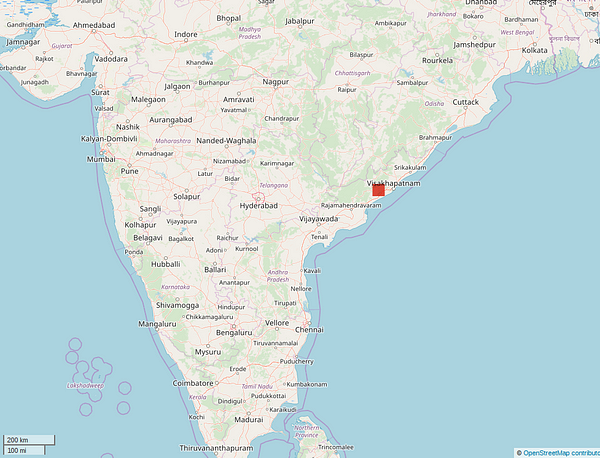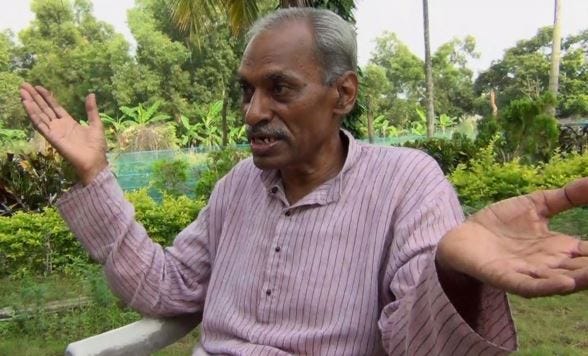Peer Learning is...
The UN FAO puts the learner in a fitting environment
Halfway down the coastal train line between Chennai and Kolkata, there’s little inland village called Annavaram. From the train station, the village is towards the mountain ridge with the single, white temple on it. As you make your way to the top, you’ll see the Pampa Resevoir on one side, and if you turn back, you can see towards the Indian Ocean, ten kilometres away.

Only about 6,000 people live in Annavaram, but its on the radar of companies like Nestle and Unilever. The region is a major agricultural producer, and through a network of co-ops and distributors, it produces a lot of the commodities that they buy and sell around the world.
But the supply is at risk and needs protecting.
Thumati Sivasankararao owns 2 acres of farmland near Annavaram. He's been a farmer for 22 years. His region is famous for black gram, which he grows on half his land. He grows turmeric on the other.
Every year, Thumati's debt increases just like most other Indian farmers. The cost of seeds, chemicals and interest rates go up, and market prices for what they sell are volatile.
Failing to control what grows, and what shouldn’t, could mean a completely destroyed field. So even though chemical pesticides and artificial fertilizers are expensive, and some of them illegal, going without is not a risk worth taking.
So each year, Thumati continues the vicious cycle of choosing the safer option of chemical farming, which gives him the best chances at a good crop, but also gradually puts him further in debt.
This type of thing happens with small-holder producers all over the world. They have to deal with pests, and crop diseases, that could wipe out their fields. And they have to work around fluctuating prices for their crops, and yearly climate fluctuations and shifts. But the one thing farmers can count on is high costs.
So more and more people give up farming and move to cities.
The large buyers of agricultural commodities, multi-nationals like P&G and Starbucks, have long realised that this is a problem to the sustainability of their supply. Governments see rural areas becoming uninhabited.
The typical interventions are to educate farmers at scale, deploying training on topics like cash management, and how to use fertiliser. The training is intended to get farmers to manage the costly inputs they are dependent on in a better way.
But to efficiently roll out the programs, this information is generally presented from text books in classroom settings, and taught by inexperienced university graduates, working for NGOs under pressure of shrinking budgets. It leaves farmers with some theory, but little more guidance on putting things to practice in their fields.
Also, the focus of the content is on producing the crop that the sponsor of the program is promoting. But many questions about managing the farm as a whole, looking at the different crops, animals, soil, and people whose livelihood depend them, are generally left out of the education experience.
By treating the farmers as students, meant to obediently consume knowledge, these programs fail to account for the farmers’ agency. In the end, they are in charge of their own farms and they are responsible for their results.
Even though Thumati sat in these classrooms, his situation kept getting worse. What he was learning was disconnected from the reality of his farm.

Mr. Subhash Palekar lives across the country in Karnataka, a lush, green region that borders the Arabian Sea. He started looking for an answer to this problem in the late 80's, and found it after 8 years of studying Karnataka's forests:
In the forest, there is no human existence, but even though the trees are having enormous fruits. That means nature had supplied all the nutrients needed for the plant. Our soil is prosperous-enriched with the nutrients!
But when I say that our soil is enriched with the nutrients, then I have to prove it scientifically.
It is the ultimate truth that without adding from outside, the plants grow and give the production. It means that, all the nutrients needed for the growth and production are available around the root zone. There is no need to add it from outside.
Palekar's method is based on observing high-yielding plants that grow in completely natural environments. It has been proven to outperform chemical farming using only inputs that are available from the farm itself. No chemicals. Nothing extra that a farmer needs to buy. The method involves mulching, choosing a combination of mutually-beneficial crops, augmenting microbial culture by processing cow dung, protecting seeds using cow urine, and managing moisture and soil aeration to minimise water vapour as there is no irrigation available. He calls it Zero Budget Spiritual Farming.
Back in Annavaram, Thumati heard about this method as Zero Budget Natural Farming. The name change came when the United Nations Food and Agriculture Organization (FAO) took it on and started organising programs around India. Thumati had heard of this program a few times, and eventually decided to join one.
From the start, Thumati noticed it was different from the way that other farming education program were organised. Where a conventional program provides farmers with explanation in theory, on a chalkboard, this Farmer Field School (FFS) was more practical because it was run by a farmer, and took place in a farm field. Thumati could now experience in practice what he needed to learn about farm management.
They are mostly focusing on soils and water management. I have observed that this is not a normal lecture mode of session. They are starting the session with an activity.
In the first week I was very happy by knowing the relation between soil and water where we have done a soil and water brigade game. In that game we have discussed about types of soil and water holding capacity of soil too.
Later in the second week, I had a "change point" here. In this session we went for soil where we have collected different types of soils. We have observed ZBNF and non-ZBNF field's soil difference, a gummy substance difference, the soil colour difference, the earthworm count between the two fields.
The main thing is the ZBNF mulched soil is so soft and smooth where as the non-ZBNF field soil beside it is too hard without any moisture.
All these data points together, observed first-hand, convinced Thumati to invest more in converting his management practice to ZBNF. He is now diversifying his crops to manage his soil optimally for growth.
By bringing the classroom to the field, Thumati experienced the application of farming knowledge first hand. As he explored his colleague’s farms, his questions were instantly dealt with. There was always someone around to respond, the facilitor, an invited agronomist, or his fellow farmers.
He thought that he wouldn’t be able to get results immediately, but it all started accelerating production even as early as 2 months into the program.
Now he is attending more of the FAO field schools, because in the end he wants to diversify the use of his crops as much as possible, and make more income from his farm. Because the program takes place in the fields, he learns when he should change his practices with his own eyes, and then learns it by doing.
